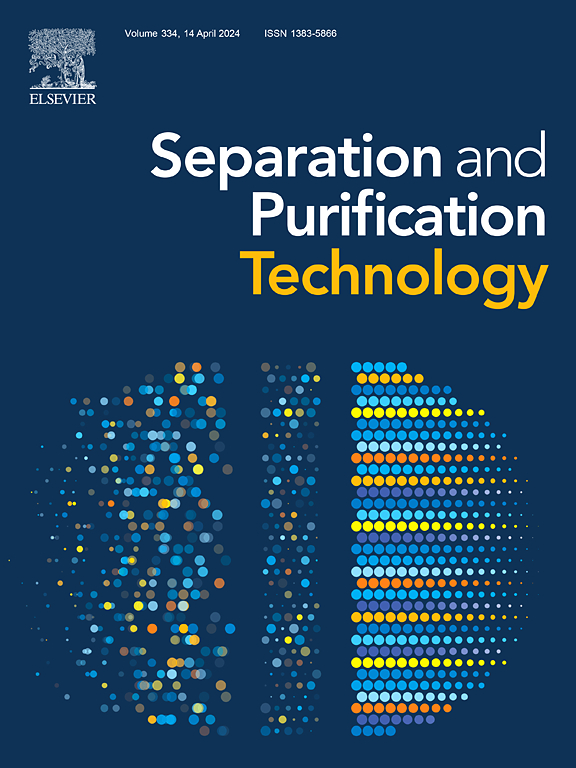Imidacloprid degradation activated by peroxydisulfate with NiCoAl layered metal oxide catalysts: The unique role of Al
IF 8.1
1区 工程技术
Q1 ENGINEERING, CHEMICAL
引用次数: 0
Abstract
Improper use of neonicotinoid insecticides (NNIs) can cause serious harm to aquatic ecosystems and human health. Despite the demonstrated excellent reactivity of nonradical persulfate activation in complex aquatic environments, the relationship between defect engineering and catalytic activity, as well as the construction of nonradical directed activation systems, remains uncertain. In this study, we synthesized and characterized Al-doped NiCoAl-LDO layered metal oxide catalysts for the first time. These catalysts were then used to activate peroxydisulfate (PDS) for degrading imidacloprid (IMI) in wastewater. Through degradation experiments and characterization analysis, singlet oxygen (1O2) and electron transfer were identified as the primary mechanisms responsible for IMI removal. Under optimized conditions (0.5 g/L catalyst loading, 1 mM PDS dosage, pH = 7.0), the degradation rate of IMI reached 0.06 min−1. The NiCo2Al1-LDO/PDS system exhibited efficient IMI degradation over a wide pH range (pH = 4–10) (> 73.6 %) and demonstrated excellent resistance against interference from anions such as Cl−, SO42−, HCO3−, CO32−, as well as Humic acid (HA). Our findings confirm that Al doping induces lattice distortion and enhances interfacial electron transfer processes in the catalyst structure, thereby facilitating the transformation from radical to nonradical pathway during the degradation process. This study not only advances our fundamental understanding of metal oxide active site doping regulation, but also presents a novel defect engineering strategy for nonradical oxidation of IMI, offering valuable insights for future research and practical applications of persulfate.

镍钴铝层状金属氧化物催化剂过二硫酸盐激活的吡虫啉降解:Al的独特作用
不当使用新烟碱类杀虫剂(NNIs)会对水生生态系统和人类健康造成严重危害。尽管非辐射过硫酸盐活化在复杂的水生环境中表现出优异的反应活性,但缺陷工程与催化活性之间的关系以及非辐射定向活化系统的构建仍不确定。在本研究中,我们首次合成并表征了掺铝的 NiCoAl-LDO 层状金属氧化物催化剂。这些催化剂随后被用于活化过硫酸盐(PDS),以降解废水中的吡虫啉(IMI)。通过降解实验和表征分析,确定单线态氧(1O2)和电子转移是去除吡虫啉的主要机制。在优化条件下(0.5 g/L 催化剂负载、1 mM PDS 用量、pH = 7.0),IMI 的降解速率达到 0.06 min-1。NiCo2Al1-LDO/PDS 系统在很宽的 pH 值范围(pH = 4-10)内都能高效降解 IMI(73.6%),并对 Cl-、SO42-、HCO3-、CO32- 等阴离子以及腐植酸(HA)的干扰有很好的抗性。我们的研究结果证实,铝掺杂会引起晶格畸变,并增强催化剂结构中的界面电子传递过程,从而促进降解过程中自由基向非自由基途径的转化。这项研究不仅加深了我们对金属氧化物活性位点掺杂调控的基本理解,还提出了一种新颖的缺陷工程策略来实现 IMI 的非自由基氧化,为过硫酸盐的未来研究和实际应用提供了宝贵的见解。
本文章由计算机程序翻译,如有差异,请以英文原文为准。
求助全文
约1分钟内获得全文
求助全文
来源期刊

Separation and Purification Technology
工程技术-工程:化工
CiteScore
14.00
自引率
12.80%
发文量
2347
审稿时长
43 days
期刊介绍:
Separation and Purification Technology is a premier journal committed to sharing innovative methods for separation and purification in chemical and environmental engineering, encompassing both homogeneous solutions and heterogeneous mixtures. Our scope includes the separation and/or purification of liquids, vapors, and gases, as well as carbon capture and separation techniques. However, it's important to note that methods solely intended for analytical purposes are not within the scope of the journal. Additionally, disciplines such as soil science, polymer science, and metallurgy fall outside the purview of Separation and Purification Technology. Join us in advancing the field of separation and purification methods for sustainable solutions in chemical and environmental engineering.
 求助内容:
求助内容: 应助结果提醒方式:
应助结果提醒方式:


